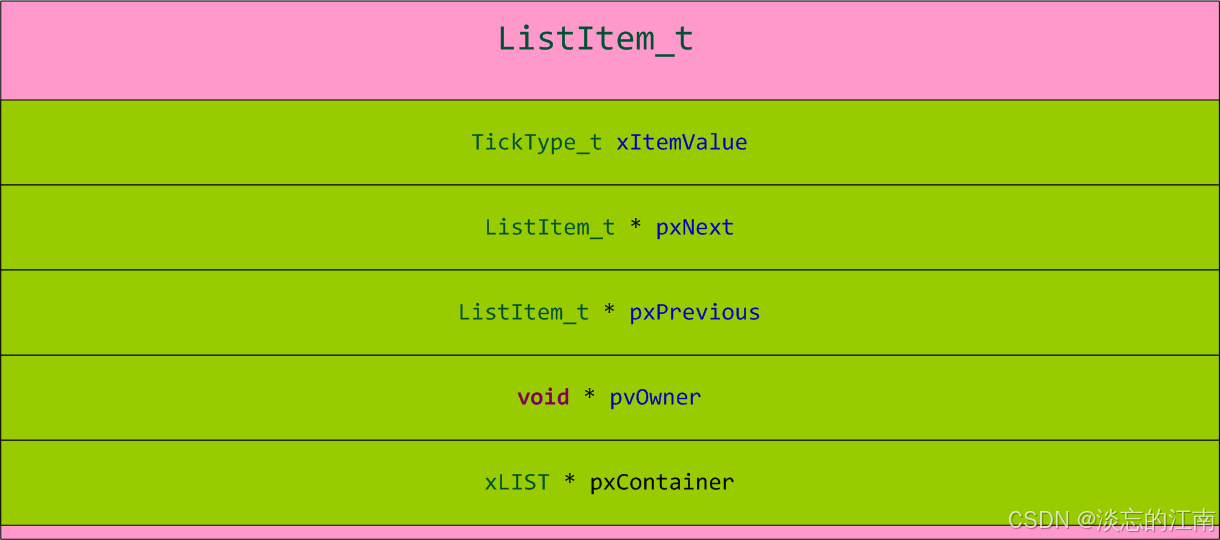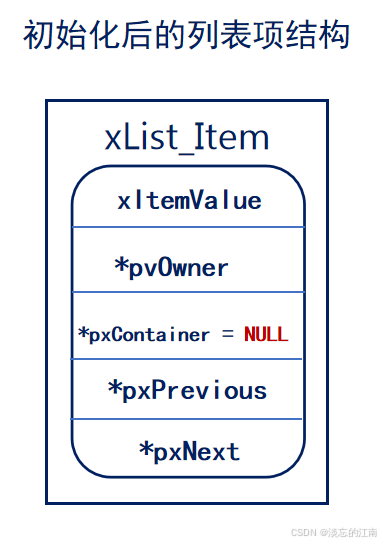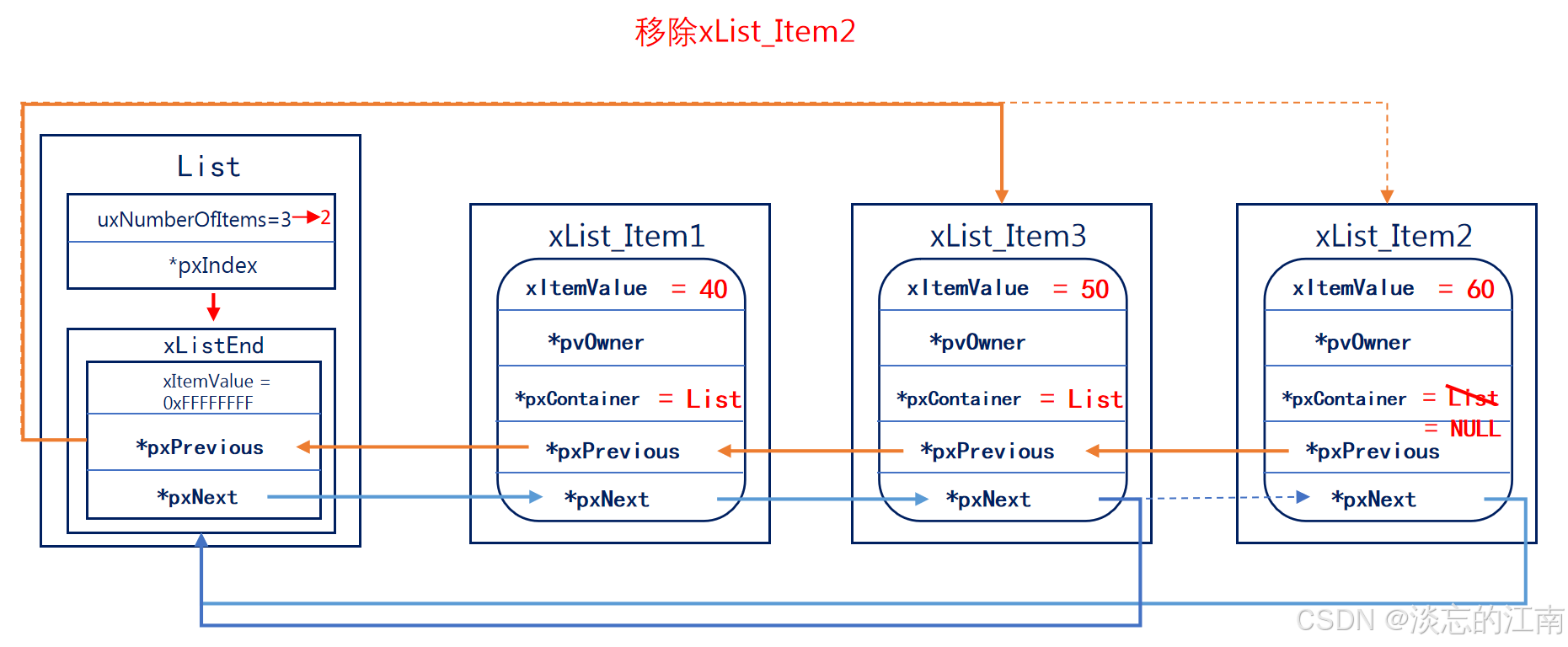《FreeRTOS列表和列表项篇》
FreeRTOS列表和列表项
- 1. 什么是列表和列表项?
- 1.1 列表list
- 1.2 列表项list item
- 2. 列表和列表项的初始化
- 2.1 列表的初始化
- 2.2 列表项的初始化
- 3. 列表项的插入
- 4. 列表项末尾插入
- 5. 列表项的删除
- 6. 列表的遍历
列表和列表项是FreeRTOS的一个数据结构,是FreeRTOS的基石。
1. 什么是列表和列表项?
1.1 列表list
- 列表在概念上类似双向链表,用来追踪FreeRTOS中的任务。
/*
* Definition of the type of queue used by the scheduler.
* 任务调度器使用的队列的定义
*/
typedef struct xLIST
{
listFIRST_LIST_INTEGRITY_CHECK_VALUE
volatile UBaseType_t uxNumberOfItems; /* 用来记录列表中列表项的个数,其中不包含末尾列表项。 */
ListItem_t * configLIST_VOLATILE pxIndex; /* 用来记录当前列表项的索引号,用于遍历列表。 */
MiniListItem_t xListEnd; /* 末尾列表项(迷你列表项),用来表示列表的结束。 */
listSECOND_LIST_INTEGRITY_CHECK_VALUE
} List_t;

1.2 列表项list item
- 列表项指存放在列表中的对象,FreeRTOS提供了2个类型:列表项和迷你列表项。
/*
* Definition of the only type of object that a list can contain.
* 定义列表可以包含的唯一对象类型
*/
struct xLIST_ITEM
{
listFIRST_LIST_ITEM_INTEGRITY_CHECK_VALUE
configLIST_VOLATILE TickType_t xItemValue; /* 列表项的值,这用于按升序对列表进行排序 */
struct xLIST_ITEM * configLIST_VOLATILE pxNext; /* 指向下一个列表项 */
struct xLIST_ITEM * configLIST_VOLATILE pxPrevious; /* 指向上一个列表项 */
void * pvOwner; /* 指向包含列表项的对象(通常是TCB)的指针。*/
struct xLIST * configLIST_VOLATILE pxContainer; /* 用来记录此列表项属于哪个列表。 */
listSECOND_LIST_ITEM_INTEGRITY_CHECK_VALUE
};
typedef struct xLIST_ITEM ListItem_t;

#if ( configUSE_MINI_LIST_ITEM == 1 ) /* 若为1,则为普通列表项,若为0,则为迷你列表项。 */
struct xMINI_LIST_ITEM
{
listFIRST_LIST_ITEM_INTEGRITY_CHECK_VALUE
configLIST_VOLATILE TickType_t xItemValue; /* 列表项的值,这用于按升序对列表进行排序 */
struct xLIST_ITEM * configLIST_VOLATILE pxNext; /* 指向下一个列表项 */
struct xLIST_ITEM * configLIST_VOLATILE pxPrevious; /* 指向上一个列表项 */
};
typedef struct xMINI_LIST_ITEM MiniListItem_t;
#else
typedef struct xLIST_ITEM MiniListItem_t;
#endif

2. 列表和列表项的初始化
2.1 列表的初始化
void vListInitialise( List_t * const pxList )
{
/* The list structure contains a list item which is used to mark the
* end of the list. To initialise the list the list end is inserted
* as the only list entry.
* 列表结构体中包含一个用于标记列表的结束的列表项(即末尾列表项)。
* 为了初始化列表,末尾列表项被插入作为唯一的列表条目。
*/
pxList->pxIndex = ( ListItem_t * ) &( pxList->xListEnd ); /* 列表的列表项索引号指向末尾列表项。*/
listSET_FIRST_LIST_ITEM_INTEGRITY_CHECK_VALUE( &( pxList->xListEnd ) );
/* The list end value is the highest possible value in the list to
* ensure it remains at the end of the list.
* 末尾列表项的列表项值是列表中可能的最高值,以确保它保持在列表的末尾。
*/
pxList->xListEnd.xItemValue = portMAX_DELAY; /* 0xFFFFFFFFUL */
/* The list end next and previous pointers point to itself so we know
* when the list is empty.
* 末尾列表项的下一个和前一个列表项指针指向自身,因此我们知道列表何时为空。
*/
pxList->xListEnd.pxNext = ( ListItem_t * ) &( pxList->xListEnd );
pxList->xListEnd.pxPrevious = ( ListItem_t * ) &( pxList->xListEnd );
/* Initialize the remaining fields of xListEnd when it is a proper ListItem_t
* 当末尾列表项是普通列表项时,初始化其剩余字段。
*/
#if ( configUSE_MINI_LIST_ITEM == 0 )
{
pxList->xListEnd.pvOwner = NULL;
pxList->xListEnd.pxContainer = NULL;
listSET_SECOND_LIST_ITEM_INTEGRITY_CHECK_VALUE( &( pxList->xListEnd ) );
}
#endif
pxList->uxNumberOfItems = ( UBaseType_t ) 0U; /* 末尾列表项不算在列表项个数中。 */
/* Write known values into the list if
* configUSE_LIST_DATA_INTEGRITY_CHECK_BYTES is set to 1. */
listSET_LIST_INTEGRITY_CHECK_1_VALUE( pxList );
listSET_LIST_INTEGRITY_CHECK_2_VALUE( pxList );
}

2.2 列表项的初始化
- 列表项的初始化此处只对pxContainer设置了初始值,其他成员变量需要根据实际使用情况初始化。
void vListInitialiseItem( ListItem_t * const pxItem )
{
/* Make sure the list item is not recorded as being on a list.
* 确保列表项未被记录为在列表中。
*/
pxItem->pxContainer = NULL;
listSET_FIRST_LIST_ITEM_INTEGRITY_CHECK_VALUE( pxItem );
listSET_SECOND_LIST_ITEM_INTEGRITY_CHECK_VALUE( pxItem );
}

3. 列表项的插入
- 注意,列表项的常规插入方式,指的是在待插入的列表List中找到比待插入的列表项ListItem的列表项值xItemValue大的列表项前边插入该列表项,列表中的所有列表项是按照其列表项值的大小手拉手链接在一起的。
void vListInsert( List_t * const pxList, /* 决定列表项要插入到哪一个列表中。 */
ListItem_t * const pxNewListItem ) /* 准备插入列表中的列表项。要插入的位置由列表项中的成员变量xItemValue决定 */
{
ListItem_t * pxIterator;
const TickType_t xValueOfInsertion = pxNewListItem->xItemValue; /* 获取要插入列表中的列表项的列表项值。 */
listTEST_LIST_INTEGRITY( pxList );
listTEST_LIST_ITEM_INTEGRITY( pxNewListItem );
if( xValueOfInsertion == portMAX_DELAY )
{
pxIterator = pxList->xListEnd.pxPrevious;
}
else
{
for( pxIterator = ( ListItem_t * ) &( pxList->xListEnd ); pxIterator->pxNext->xItemValue <= xValueOfInsertion; pxIterator = pxIterator->pxNext )
{
/* There is nothing to do here, just iterating to the wanted
* insertion position. */
}
}
pxNewListItem->pxNext = pxIterator->pxNext;
pxNewListItem->pxNext->pxPrevious = pxNewListItem;
pxNewListItem->pxPrevious = pxIterator;
pxIterator->pxNext = pxNewListItem;
/* Remember which list the item is in. This allows fast removal of the
* item later. */
pxNewListItem->pxContainer = pxList; /* 将列表项的成员变量pxContainer赋值为插入的列表。 */
( pxList->uxNumberOfItems )++; /* 列表的列表项总个数自增1 */
}



4. 列表项末尾插入
- 注意,列表项末尾插入的方式,指的是在列表的成员变量pxIndex所指向位置的前边插入待插入的列表项,与列表项的列表项值没有关系。
void vListInsertEnd( List_t * const pxList,
ListItem_t * const pxNewListItem )
{
ListItem_t * const pxIndex = pxList->pxIndex;
listTEST_LIST_INTEGRITY( pxList );
listTEST_LIST_ITEM_INTEGRITY( pxNewListItem );
pxNewListItem->pxNext = pxIndex;
pxNewListItem->pxPrevious = pxIndex->pxPrevious;
mtCOVERAGE_TEST_DELAY();
pxIndex->pxPrevious->pxNext = pxNewListItem;
pxIndex->pxPrevious = pxNewListItem;
/* Remember which list the item is in. */
pxNewListItem->pxContainer = pxList;
( pxList->uxNumberOfItems )++;
}



5. 列表项的删除
- 如果这个列表项是动态分配内存的,列表项的删除只是将指定的列表项从列表中删除掉,并不会将这个列表项的内存释放掉。
UBaseType_t uxListRemove( ListItem_t * const pxItemToRemove )
{
List_t * const pxList = pxItemToRemove->pxContainer;
pxItemToRemove->pxNext->pxPrevious = pxItemToRemove->pxPrevious;
pxItemToRemove->pxPrevious->pxNext = pxItemToRemove->pxNext;
mtCOVERAGE_TEST_DELAY();
if( pxList->pxIndex == pxItemToRemove )
{
pxList->pxIndex = pxItemToRemove->pxPrevious;
}
else
{
mtCOVERAGE_TEST_MARKER();
}
pxItemToRemove->pxContainer = NULL;
( pxList->uxNumberOfItems )--;
return pxList->uxNumberOfItems;
}

6. 列表的遍历
- 列表结构体中的成员变量pxIndex是用来遍历列表的。
- FreeRTOS提供了一个函数来完成列表的遍历,函数是listGET_OWNER_OF_NEXT_ENTRY( pxTCB, pxList )。每调用一次这个函数,列表的pxIndex变量就会指向下一个列表项,并且返回这个列表项的pvOwner变量值。
#define listGET_OWNER_OF_NEXT_ENTRY( pxTCB, pxList ) \
{ \
List_t * const pxConstList = ( pxList ); \
/* Increment the index to the next item and return the item, ensuring */ \
/* we don't return the marker used at the end of the list. */ \
( pxConstList )->pxIndex = ( pxConstList )->pxIndex->pxNext; \
if( ( void * ) ( pxConstList )->pxIndex == ( void * ) &( ( pxConstList )->xListEnd ) ) \
{ \
( pxConstList )->pxIndex = ( pxConstList )->pxIndex->pxNext; \
} \
( pxTCB ) = ( pxConstList )->pxIndex->pvOwner; \
}
